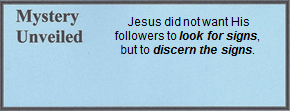10.01.26 Mt. 16:1-4; Mk. 8:13; Magadan
PHARISEES AND SADDUCEES ASK FOR SIGN
Mt. 1 The Pharisees and Sadducees approached, and as a test, asked Him to show them a sign from heaven.
2 He answered them: “When evening comes you say, ‘It will be good weather because the sky is red.’ 3 And in the morning, ‘Today will be stormy because the sky is red and threatening.’ You know how to read the appearance of the sky, but you can’t read the signs of the times. 4 An evil and adulterous generation demands a sign, but no sign will be given to it except the sign of Jonah.” Then He left them and went away.
Mk. 13 Then He left them, got on board the boat again, and went to the other side.
Again, his accusers questioned Jesus. There was hardly any privacy in his life, as he and his disciples were followed and spied upon continuously. As a Roman gladiator would entangle his victim with a net before a kill, so the Pharisaic spies attempted to entangle Jesus with trick questions in order to kill him. One can therefore understand the attitude of the disciples at the time of crucifixion. If the powerful Jesus was finally put to death, they would be also.
“The Pharisees and Sadducees.” Amazingly, Mark refers to the Sadducees only once by name while Luke refers to them five times, but only in his book of Acts. John never calls them by name at all. Yet they were the primary instigators that led to the crucifixion. The leading Pharisees clearly challenged Jesus numerous times and even planned His death, but eventually they stepped aside and let the Sadducees do their dirty work.
“Asked Him to show them a sign from heaven.” What was the reason for their request? Did they really want to know if Jesus was the Messiah? Or were they looking for another reason that could be charged against Him? Jesus, as the true Divine, would not condescend to their arrogant requests, trickery, and criticisms. They had already made their decision; a decision of rejection. Yet, there would be one more sign that would be absolutely stunning.
“An evil and adulterous generation.” Jesus, no doubt filled with righteous anger, again called the Jewish leaders an adulterous generation (Mt. 12:39; Mk. 8:38). The word adulterous (Gk. moichalis, 3428) means one who has unlawful intercourse with the spouse of another,[1] which, in this case, also means apostate.[2] Since God desires a close relationship with His people that is both a covenant and mirrors a marriage covenant, departure of faith and obedience is seen as adultery and apostasy.
10.01.26.Q1 Does Mark 8:12 conflict with Matthew 12:39 and 16:4?
At the center of this conflict is this statement, “No sign will be given to it except the sign of Jonah.” When the critics wanted a sign, Matthew and Mark each stated that there would not be any more. Note that Matthew’s writing style is somewhat more detailed than Mark’s. In 12:39 and 16:4 Matthew said that there would be no sign with one exception – the sign of Jonah the prophet. Mark, on the other hand, did not include the exception (see 8:12). There is no error here, simply a difference in writing styles. [3] Jesus did not want His followers to look for signs, but to discern the signs that were to come. Yet there would be three signs for them to consider:
- The resurrection of Lazarus
- The resurrection of Jesus
- The resurrection of the two witnesses (Rev. 11).

The religious leaders, who most certainly remembered when 12-year old Jesus was asking them questions at the temple steps, had carefully observed His every move throughout His ministry. Their request for another miracle was not to see His divine nature, but to entrap Him. If they did not accept what was already obvious and readily known, including the messianic miracles, and they certainly would not accept any other signs. Therefore, the phrase “wicked and adulterous generation,” describes them perfectly. It did not mean every person of that generation. But the sign of Jonah, in this context, is clearly the sign of the resurrected Jesus.
As confrontations with the religious establishment increased, Jesus directed His journey in a manner that would eventually lead Him to Jerusalem at Passover. He lived the life of a fugitive; ministering in areas where people needed Him while giving His disciples additional instruction.
[1]. Vine, “Adulterer (-ess), Adulterous, Adultery.” Vine’s Complete Expository Dictionary. 2:14.
[2]. Barclay, “Matthew.” 2:49.
[3]. The gospel writers not only recorded various events and teachings of Jesus, but each writer applied his own style to emphasize the importance of his message. Mark not only wrote ideas in poetic style, but also themes – a writing technique that helped his audience memorize his message. See an example of the poetic themes of Mark 6:31 – 8:30 in Appendix 11.